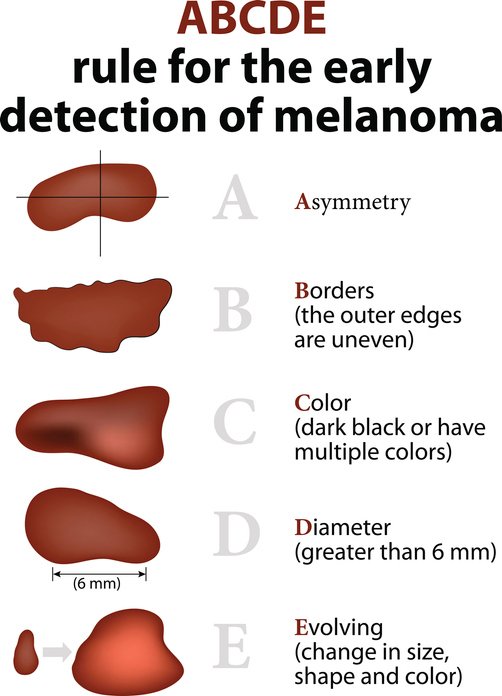Skin cancer can happen to anyone. The frustrating part is how it tends to sneak upon us. It’s easy enough to spot on the face, hands, and feet, but what about the back and shoulders? While it’s impossible to diagnose skin cancer without seeing a medical professional for an evaluation, here are some signs of what skin cancer looks like, and tips to help you prevent it.
What is Skin Cancer?
Skin cancer is one of those terms you hear thrown around, but it doesn’t really mean anything to you until either someone you know or you yourself are diagnosed with it. With so many types of cancer out there, it’s easy enough to assume that it’s just moles that turn black or look a little weird. While that’s true, there’s a bit more to skin cancer than just that.
According toThe Skin Cancer Foundation, “Skin cancer is the out-of-control growth of abnormal cells in the epidermis, the outermost skin layer, caused by unrepaired DNA damage that triggers mutations. These mutations lead the skin cells to multiply rapidly and form malignant tumors.”
In other words, when your skin becomes damaged and doesn’t heal properly, you are at higher risk of developing skin cancer. So what causes this?
What Causes Skin Cancer?
The two main culprits of skin cancer revolve around sunlight and tanning beds. The light damages the skin, and if the skin doesn’t heal properly, even if it looks like it does on the surface, it can become cancerous.
This can seem like a double-edged sword when it comes to sunlight. You need those precious rays in order to get enough Vitamin D. Even if you’re taking supplements, the sun is still a better source. According to Yale Medicine, it allows you to manufacture your own Vitamin D.
You can spend too much time in the sun, however. If your skin is starting to look red, you’re sweating excessively, or feel ill, then it’s time to get out of the sun. A good rule of thumb is fifteen to twenty minutes a day of sunlight.
As far as tanning beds go, it’s a good idea to skip them. While there is a push to have that beautiful glow, the risks are extremely high. The Skin Cancer Foundation reports, “Tanning outside or indoors can have dangerous consequences. While often associated with good health, the “glow” of a tan is the very opposite of healthy; it’s evidence of DNA injury to your skin. Tanning damages your skin cells and speeds up visible signs of aging. Worst of all, tanning can lead to skin cancer.”
What Does Skin Cancer Look Like?
Now that we’ve discussed what skin cancer is and what causes it, we need to discuss what it looks like. The most well-known thing to look out for is new moles that come up quickly, turn black or old moles that are changing appearance.
There’s more to skin cancer than that, however. It can be any lumps, bumps, spots, sores, or other marks on your skin that are new or changing. This means a strange red spot that doesn’t go away, or even tiny moles could be cancerous.
It all depends on the type of skin cancer it is. If it is skin cancer, of course. Just because you have a spot come up that doesn’t heal within a week, it doesn’t mean you have skin cancer. That’s something that needs to be determined by a doctor. With that being said, here are the three most common types of cancer.
Types of Skin Cancer
Skin cancer has many different shapes and forms. The most well-known type is melanoma, but there are others.
Melanoma
This type of skin cancer develops in the melanin in the skin. This is what gives it color. Because of this, melanoma will often appear darker in color. While it is the most dangerous type of skin cancer, if caught early, it’s treatable.
Basal Cell Carcinoma
This is the most common type of skin cancer and is rarely fatal. It’s typically caused by accumulative exposure to the sun affecting the basal cells in the epidermis and is most often found on the face, ears, neck, scalp, shoulders, and back.
Squamous Cell Carcinoma
Damage from the sun to the squamous cells is the cause of this cancer. It’s most often found on the ears, face, scalp, neck, and hands. Squamous cell carcinoma can be fatal if not caught early.
Skin Cancer Symptoms
As we’ve already discussed, there are several different types of cancer, and they don’t all look the same. This makes identifying symptoms of skin cancer harder. A good rule of thumb is anything new that doesn’t heal or go away within a week or two needs to be checked out by your doctor.
The CDC recommends using the ABCs if you suspect a mole or new mark might be melanoma:
- “‘A’ stands for asymmetrical. Does the mole or spot have an irregular shape with two parts that look very different?”
- “‘B’ stands for border. Is the border irregular or jagged?”
- “‘C’ is for color. Is the color uneven?”
- “‘D is for diameter. Is the mole or spot larger than the size of a pea?”
- “‘E’ is for evolving. Has the mole or spot changed during the past few weeks or months?”

It’s important to take the time to look in the mirror at least once a month to look for new growths or changes to existing ones. This will help you become familiar with your body, so you know what’s normal and what isn’t.
Skin Cancer treatment
If your doctor diagnoses you with skin cancer, there are options. It will depend on what type of cancer you have, of course, but here are some of the more common treatments.
Removing cancer through surgery is a common method, especially if it’s caught early. This gives the doctor the opportunity to send it off, so it can be tested.
If cancer has spread, more traditional treatments like chemo and radiation may be used. Immunotherapy is another method, which boosts your immune system, so it can fight cancer itself. Your doctor will come up with a plan tailored to your specific needs.
How Can You Prevent Skin Cancer?
While there are no definite ways to prevent skin cancer, you can lower your chances of getting it. Avoid tanning beds, as there is no real benefit from it, and the glow you get is deceptive. Also, use sunscreen when going outdoors. If you think you’ll be outside for long periods of time, like at a baseball game, using long sleeves and staying in the shade will help lower your risk.Do you suspect you have skin cancer? If so, don’t stress about the unknown. Make an appointment with The Women’s Clinic today.



 Close
Close